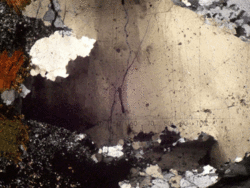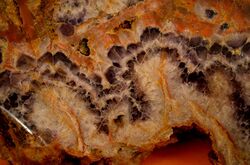Astronomy:Rajlich's hypothesis

Rajlich's hypothesis is a physical hypothesis with a significance for geology.[2][3] There exist macroscopic white lamellae inside quartz and other minerals in the Bohemian Massif and even at another places in whole of the world like wavefronts generated by a meteorite impact according to the hypothesis. The hypothetical wavefronts are composed of many microcavities. Their origin is seen in a physical phenomenon of ultrasonic cavitation, which is well known from the technical practice.
The cavities are usually made inside liquids, not in solid state media. The meteorite hit should fluidize the minerals, and mechanical waves of high frequency should tear them.
Based on the technical practice it is known that a cavity implosion inside liquid generates high temperatures of thousands of kelvins and even a shock wave.[4] There are found many intersecting systems of white lamellae inside quartz at many localities from the Bohemian Massif. It can be assumed that according to high number of wavefronts transferred through the minerals and resulting high number of cavity implosions, the structure of quartz was partially disrupted during the fluidization and the distribution of prevailing pressure was respected during the transfer into a solid state.[clarification needed] There could be then preferred a creation of denser quartz in the area of higher pressure.[clarification needed] This means a creation of smaller basic molecular Si-O rings. The situation in the area of lower pressure could be opposite. A finding of such harmonic signature of the quartz density is considered to be an option for the hypothesis verification.[clarification needed][5]
The author of the hypothesis is a Czech geologist Petr Rajlich. It is connected with the Czech Crater hypothesis.
Interesting facts
The shapes of the microcavities are between spheres and negative crystals.
There is seen a probable erasure of older sets of lamellae by new sets in quartz with hypothetical cavitation lamellae, which is presented by Rajlich in few samples.[3] A similar distribution is common in quartz with conventional PDF lamellae. Their presence is a today's recognized criterion for a verification of impact structures.
The cavitation lamellae sometimes seem like small teeth or pillars,[3] which is a well known effect from today's verified impact structures. The teeth become visible after acid etching. The effect is called pillaring.[6]
The minerals are not always cut by lot of lamellae, but are absolutely torn up or cut like slices. This is observable for example in the case of tourmalines from Czech pegmatites.
The spacing of cavitation lamellae can be from millimeters up to meters. A consolidation into compact blocks by fluidization of more smaller grains is suggested in the case of large quartz cores from pegmatites.
Ultrasonic cleaning effects that are well known from the technical practice are also discussed. Quartz between lamellae is very clear and thus contains almost no fluid inclusions. There exists an assumption that they collapsed due to many mechanical pulses.
There is found a grooving pattern on some samples of quartz. It looks like surface waves.
Many rose quartz samples from the whole of the world contain systems of white lamellae. A causal relationship between the shock metamorphism and the origin of rose color could define the rose quartz as a shocked mineral. A similar relationship could be true also in the case of other quartz varieties.
Mechanical or electromagnetic waves move without mutual influencing. The cavitation lamellae intersect each other without visible mutual influencing, for example without mutual movements, as well. It is typical for various types of fractures and deformation lamellae that are connected with quartz undulose extinction.
Rock fluidization due to a meteorite hit was already theorized and experimentally tested by H. J. Melosh and E. S. Gaffney in the 1980s.[7]
If we estimate the wavelength from the spacing of hypothetical cavitation lamellae, we get values that are equal to fractions of meters. We then obtain the frequencies in the order of min. 106 Hz from the assumption that the waves going through rocks were of higher speed than the speed of the meteorite just before the hit (tens of thousands meters per second). The initial pressure impuls should even generate the waves of frequencies in the order of 1013 Hz according to the hypothesis. This equals to typical frequencies of molecular vibrations. Such waves could be responsible for a short liquid behavior of quartz and other minerals.
The white lamellae frequently segue into shapes of wispy trails. Real experiments in liquids showed that such structures arise after a collapse of traveling bubble cavitation.[8]
Other Explanations
The white lamellae are conventionally explained by two other ways. They can be zonal growths or tensile fractures that could be reactivated (healed) in many ways. The first option is less probable, because the lamellae intersect each other. The zonal growths respect the crystallographic planes. The second option is much more probable. Variations of tensile fractures can be found for example in ice.[9] An example can be the Jupiter's moon Europa that has a surface, which is cut by a dense net of fractures. However the tensile fractures and various ruptures have in comparison to hypothetical cavitation lamellae usually not a straight shape, they are radially distributed, cracked or one fracture is linked to another fracture in its certain part.
References
- ↑ Raymond, J. C.; Curiel, S. (1994-01-01). Dyson, J. E.. ed (in en). Kinematics and Dynamics of Diffuse Astrophysical Media. Springer Netherlands. pp. 303–309. doi:10.1007/978-94-011-0926-0_49. ISBN 9789401043991.
- ↑ 1944-, Rajlich, Petr (2007-01-01). Český kráter. Jihočeské muzeum. ISBN 9788086260808. OCLC 276814811.
- ↑ 3.0 3.1 3.2 1944-., Rajlich, Petr (2014-01-01). Vesmírná příhoda v Českém křemeni (a v Českém masivu). Geologie. ISBN 9788026056782. OCLC 883371161.
- ↑ Suslick, Kenneth S. (1989). "The Chemical Effects of Ultrasound" (in en). Scientific American 260 (2): 80–86. doi:10.1038/scientificamerican0289-80. Bibcode: 1989SciAm.260b..80S. https://www.scientificamerican.com/article/the-chemical-effects-of-ultrasound/.
- ↑ Mestan, J.; Alvarez Polanco, E. I. (2014-12-01). "Density Variations in Quartz As a Key for Deciphering Impact-Related Ultrasonic Sounding (Rajlich's Hypothesis)?". AGU Fall Meeting Abstracts 11: MR11A–4310. Bibcode: 2014AGUFMMR11A4310M.
- ↑ "Characterization and significance of shocked quartz from the Woodleigh mpact structure, Western Australia (PDF Download Available)" (in en). https://www.researchgate.net/publication/227846436.
- ↑ Melosh, H. J.; Gaffney, E. S. (1983). "1983LPSC...13..830M Page 833". Lunar and Planetary Science Conference Proceedings 88: 830. doi:10.1029/JB088iS02p0A830. Bibcode: 1983LPSC...13..830M.
- ↑ 1941-, Brennen, Christopher E. (Christopher Earls) (1995-01-01). Cavitation and bubble dynamics. Oxford University Press. ISBN 9780195094091. OCLC 30508570.
- ↑ Schulson, E. M. (1991-01-01). "The Tensile and Compressive Fracture of Ice". in Jones, Dr Stephen (in en). Ice-Structure Interaction. International Union of Theoretical and Applied Mechanics. Springer Berlin Heidelberg. pp. 165–187. doi:10.1007/978-3-642-84100-2_10. ISBN 9783642841026. https://archive.org/details/icestructureinte1989pont.
Gallery
White lamellae inside rose quartz from Pisek pegmatites (hand specimen) like hypothetical cavitation wavefronts.
Quartz from Blanice River with distinct tectonic fractures and mylonitization that look like a younger event in comparison to the white lamellae. The tectonic fractures could be related to ultrasonic fatigue, which is the effect that has been well established in the technichal practice and the work with ultrasound. There are wispy trails in the mylonitized area. They could be relics after the bubble collapse.















